Native Plant Garden Tour: A Backyard Paradise
- Nuts for Natives
- Sep 15, 2021
- 6 min read
Updated: Sep 21, 2021
A stunning native plant garden accommodates entertaining, kids' play areas and nature!

I knew Ashley's garden would be a great one as her garden was recently voted best large native plant garden through the exciting effort by the Green Towson Alliance to promote native plants. I really wasn't prepared though for how beautiful, creative and idea filled it would be. The most amazing part of this garden is that Ashley and her family have lived in the home for only 6 years. I am truly awed.
This garden has its origins in Baltimore City where Ashley was living when her husband, Aaron, bought her a Doug Tallamy book, probably prompted by an Amazon auto-suggest he says. Ashley read it, and as a middle school science teacher, immediately got it and got to it. The plants we choose really matter. She went to the now closed Behnkes Nursery in Beltsville thinking the nursery's large size would increase her chances of finding native plants. The choices were slim but she made do and filled the small bed in front of her row home with natives. This was before Ashley knew of the bountiful selections of natives at nearby Herring Run Nursery, now her favorite nursery.
Soon thereafter, Ashley and family moved to Towson. They started with a number of non-native trees and shrubs, numerous hostas (Hosta), lots of ivy (Hedera helix) and vinca (Vinca minor), several ornamental grasses, and Chinese wisteria (Wisteria chinensis) which still pops up in the yard every year from remaining fragments of the root deep in the ground. Ashley and Aaron knew they needed a clean slate and spent a month of weekends hand clearing as much of the fifth of an acre lot of non-natives and invasives as they could. Since then, they have removed six non-native trees and added almost thirty native trees. Where they cleared, the vinca and ivy have stayed away. In one small area at the back of their garden, they left vinca in place to prevent hillside erosion as they figure out how they would like to design this area. In the meantime, Ashley has let Virginia creeper (Parthenocissus quinquefolia) grow over the vinca, an experiment to see if the Virginia creeper can overtake and crowd out the vinca.

While Virginia creeper is an aggressive grower, it provides summer color and flowers followed by blue berries and brilliant fall coloring. It makes a good ground cover if you have a lot of ground to cover.
Today, the charming front of the home in the Greenbrier neighborhood has a front porch, a very small lawn and a fairly traditional planting design, almost all natives, and a newly planted willow oak: beautiful, traditional and in keeping with the style of the neighborhood. Inkberry shrubs (Ilex glabra) underplanted with semi-evergreen green and gold ground cover (Chrysogonum virginianum) and seersucker or plantain leaf sedge (Carex plantaginea) grace the foundation. As you move out from the front walk, winterberries (Ilex verticillata), a sweet bay magnolia (Magnolia virginiana) and perennials transition the feel to something less formal.

The artful arrangement of repurposed dead wood at the head of the permeable driveway tips you off that there is something very special in store. In addition to the artistry, dead wood serves as insect habitat. Ashley got the wood from a neighbor who earlier this summer had a dead oak cut down. Her plan was to insert the pieces in various places throughout the garden - as little stools, bird bath holders and decorative pieces. In the meantime, she artfully arranged them to look somewhat intentional on the driveway. They have turned out to be popular with the neighborhood kids as stools and a "balance beam."

You enter the garden through a gate to the side of the home. A generous path bordered by many native shrubs and clusters of shade loving perennials beneath mature trees reveals a glimpse of the patio and garden beyond. Wood is used to line paths, mark grade changes and to highlight features. One of many lessons I took away is to make paths as wide as you can; that extra space is transformative.
Once you reach the rear of the house, a patio and several garden terrace levels below unfold. This is a garden of lush plantings that sweep you one way, down a level and then back the other way. Ashley says she can't name a favorite native plant; she just loves all shrubs! Her love of shrubs makes for these very full, graceful contours providing three and four seasons of interest and so much wildlife habitat.
Favorite shrubs used in multiples around the garden include winterberry, oak leaf hydrangea (Hydrangea quercifolia), summer sweet (Clethra alnifolia), bush honeysuckle (Diervilla sessilifolia), silky dogwood (Cornus amomum), red twig dogwood (Cornus sericea), red and black chokeberries (Aronia arbutifolia and Aronia melanocarpa) and sweetspire (Itea virginica). The bush honeysuckle is an interesting choice because of foliage which turns form dark green to a more orange cast, seen here, to red or purple in fall. It also has a fairly neat shape. I have not grown this but Ashley said, two years in, it is very low maintenance. Using deciduous shrubs in this way creates structure for all seasons.

The entertaining terrace includes lots of perennials in pots. Ashley likes the idea of using perennials in containers to reduce work and cost. Liatris (Liatris spicata) and mistflower (Conoclinium coelestinum) are a few of the plants in containers. There is also a water garden in a container. Mosquitos are kept at bay with a solar powered floating fountain to move water during the day and mosquito dunks.
The perennial garden centered in the middle terrace is a beautiful example of drought tolerant plants looking good in full sun in August. One of Ashley's gardening principles is she only waters if plants really need it. Her rule of thumb: "If I think something needs watering, I wait two weeks and, if it has not rained, I'll water." This summer for example, she watered her sunny perennial garden twice, in July. This is a testament to Ashley's skill at getting the right plant in the right place. She does not hesitate to move something if it is not thriving. She said she has moved a red buckeye tree (Aesculus pavia) five times in five years but it is now finally happy.

This is a kid friendly garden too. While Ashley's children have, at times. lamented the lack of a large grass lawn, this is more than made up for by the fact they have the best hide and seek garden of anyone they know. And this garden is truly a bird paradise. In addition to birds feasting on native berries and seeds, the kids have created their own secret "Birdland" on a lower terrace beneath the canopies of understory trees. Ashley says as a result of the garden, her children have unknowingly become birdwatchers and are pretty good at identifying a variety of bird species - in addition to an impressive array of plants. As a biologist, this of course makes her proud!

Ashley, now a coach for other science teachers, is keeping current on all of her science lessons, naturally. Doug Tallamy, the now well known native plant advocate, author and entomologist at the University of Delaware, answered one of the most common gardening questions over the past year: how to deal with mosquitoes. His message is that fogging does not work. Even naturally occurring sprays are indiscriminate; they kill beneficial insects and it is only a momentary deterrent to mosquitoes. Instead, he suggests filling a five gallon bucket with water, a clump of hay or straw and a mosquito dunk. Dr. Tallamy says mosquitoes find the decaying brew irresistible, lay eggs there and then the mosquito dunk prevents mosquito larvae from hatching. Ashley is quick to say she does not have a rigorous science experiment underway; rather she deployed two buckets, one on either side of the house, to give it a try and so far, so good. Ashley keeps a lid on her bucket, drilled the lid and the sides of the bucket just beneath the rim with 1/4 inch holes, and adds a fresh mosquito dunk and handful of straw monthly. Ashley added the lid to keep the kids, puppy, and backyard wildlife out of the bucket. Doug Tallamy thinks a 1/2 inch screen would be the best cover to allow easier access for female mosquitoes but Ashley has quite a host of garden visitors she needs to think about.

This garden has it all -- great design, works for the entire family, employs all the sustainability practices and is a haven for nature. As I left, I told Ashley I feel like I had been on a mini-vacation visiting her garden. So lovely. Oh, and thanks for all of the lessons Ashley. The mark of a truly skilled teacher; having so much fun you don't even realize you are learning!




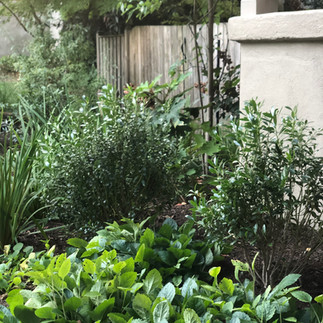





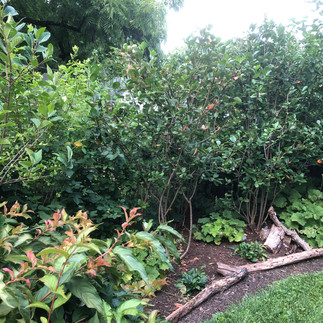
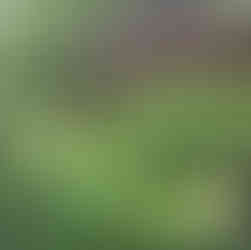












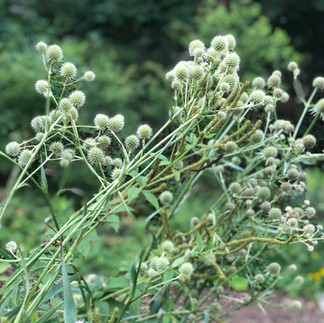



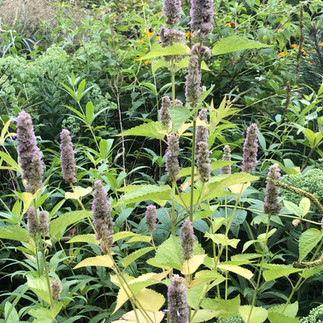








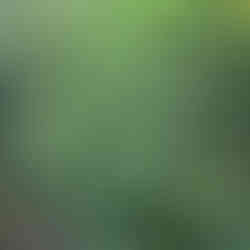













Comments